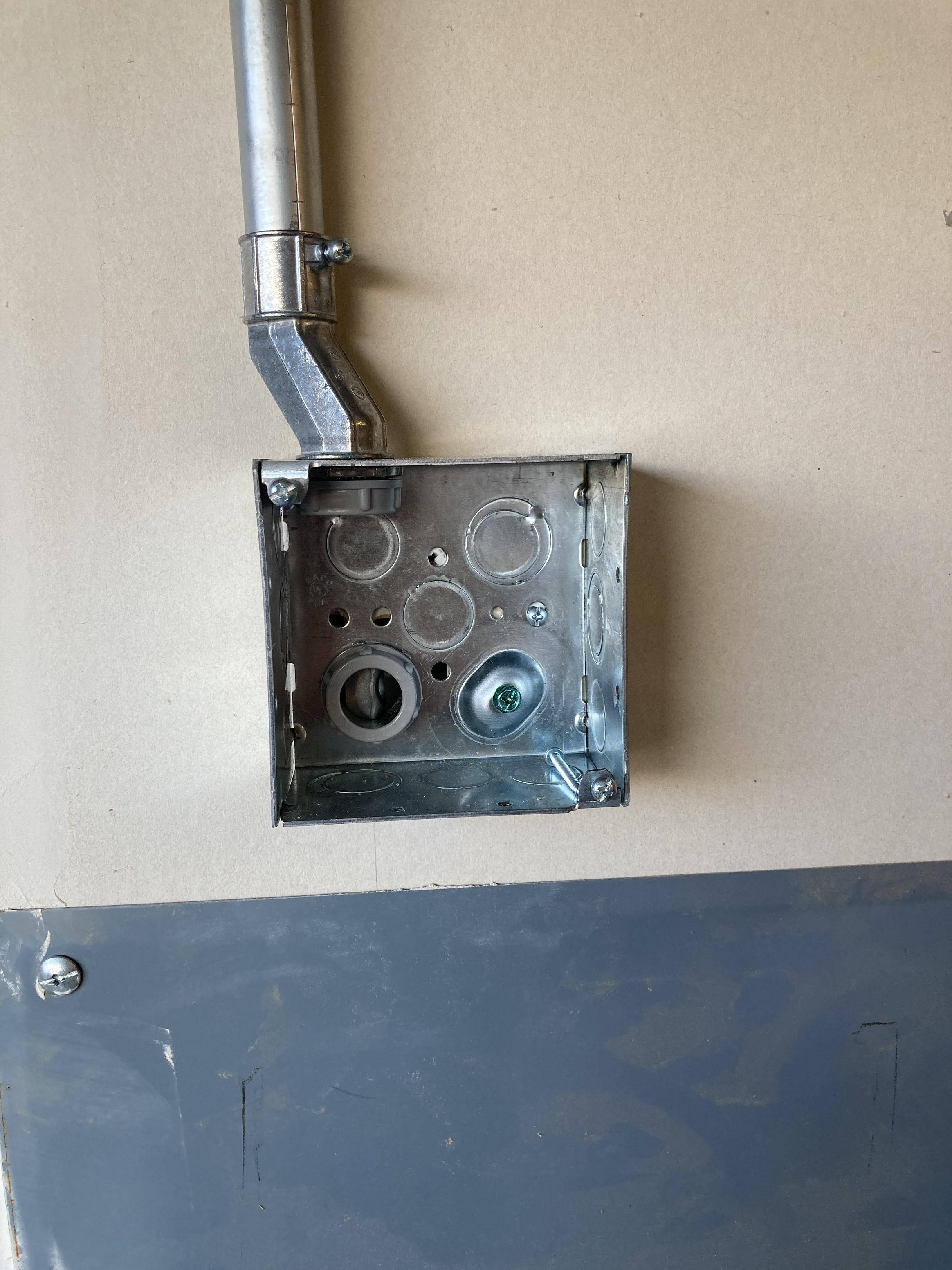What is the best way to transition from THHN wiring in exposed conduit to a wall panel inside a wall? The conduit holds wiring for a 120v circuit and a 240v circuit with power outlets. I was going to use a 4x4 junction box to transition through the back of the box into the wall using using romex behind the wall. It is my understanding that you can't put both lines through the same knockout because they are different voltages but not sure how to mount a junction box on sheetrock with two rear knock outs broken out. Seems like a lot of sheetrock would need to be removed to do that. Any ideas welcome.
-
How elegant do you want this to look? There're ugly ways (such as transitioning to flex that then nosedives thru the drywall, or simply sending the EMT through the drywall with a double bend) and semi-neat ways (transitioning to flex, then bringing that flex into the front of your JB, with conduit or cable running concealed from the JB to the panel), but I haven't heard of a truly elegant way to do this that doesn't violate NEC 314.29.– ThreePhaseEelCommented Mar 27, 2021 at 23:24
-
Also, as a NB, there is absolutely nothing wrong with bringing 120 and 240 circuits in via the same KO.– ThreePhaseEelCommented Mar 27, 2021 at 23:25
-
There are many example in code of 120-240 circuits in the same pipe, box , panel. in a multiwire branch circuit there are examples of them on the same duplex receptacle. Since the Sheetrock is nothing special (just a basic tape job) I would have cut a section out and put a dog leg in the emt and gone directly into the panel. Cheaper and would look better no unnecessary splices.– Ed BealCommented Mar 28, 2021 at 15:05
-
the best way is to finish running the EMT (if it's required to be in EMT, then it's required to be pullable so you cannot use FMC).– MazuraCommented Oct 15, 2022 at 19:31
2 Answers
Ditch the box
The simplest way to do this would be to use an EMT-to-FMC coupling and a length of flexible metal conduit of the same size as your EMT that "dives" into the wall and lands in a straight-in FMC fitting atop the panel, as it appears you have enough length in your wires to do this. You'll need to remove the box and offset nipple first, though!
You could also use a bent section of like-sized EMT and a coupling to make the "dog leg" through the drywall. This may be more attractive than transitioning to FMC if you're handy with a conduit bender.
If you come up short...
If that doesn't work out, probably because the wires are too short, then you can flush mount the box, with a wiring method of your choice (I'd use a rigid or EMT nipple and locknuts, myself) from the box to the panel, then use a short length of FMC and the EMT-to-FMC coupling from before to attach the conduit to a right-angle FMC connector mounted into a KO faceplate (Steel City 52C6, shown below, or equivalent for a 4" square box) on the box.
Or, use an extension
If the flex whip isn't appealing to you, but a box sticking out isn't a bother, you could use a flush-mounted 4" square box as above, but with an extension box (such as the Raco 203 shown below, NoSparksPlease's Raco 187 is designed to fit over a switch opening instead of the full box opening) and blank faceplate instead of the flex whip and KO faceplate, so that the EMT can come directly into the top of the extension box.
-
Um using a KO on a faceplate? What about the dead face? I don’t know an inspector that would allow that. A KO into the box sure.– Ed BealCommented Mar 28, 2021 at 15:10
-
@EdBeal -- I'm referring to something like a Steel City 52C6 where the cover is blank save for the KO. I'll add the reference to the answer Commented Mar 28, 2021 at 15:27
-
Ok that was not clear but a box extension would be the normal way to make this transition with surface mount as any splices have to be accessible.– Ed BealCommented Mar 28, 2021 at 17:47
-
Can't bury flex in a wall where EMT is required by code as that's not pullable.– MazuraCommented Oct 15, 2022 at 19:31
-
@Mazura -- being unable to have flex in a wall is news to me -- can you provide a Code cite for that one? Commented Oct 15, 2022 at 19:56
If your concern is that you have to cut away a lot of material to support the surface mounted box you might replace your existing box with a Raco 187 and put a cut-in box or two behind the 187. If you use two ganged cut-in boxes in the wall that gives you a little more room to get your hand in the wall trying to fish wires or flex down the inside of the wall to the panel. You have to mount the 187 with the window horizontal if you use two cut-in boxes.
I would connect the box to the panel with FMC or ENT to accommodate future changes. If you're up for patching some drywall I might move the box a little higher to give some more room for wire or cable flexibility.




